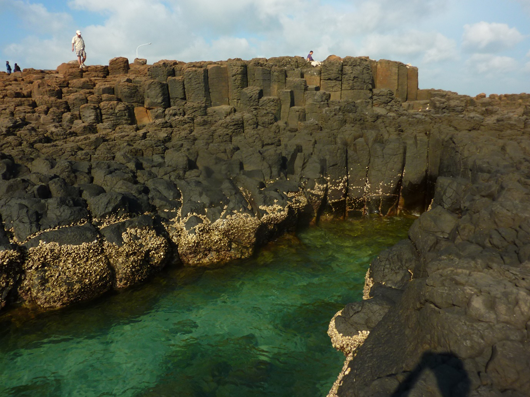DesalData Weekly - November 11, 2015
Posted 11 November, 2015 by Mandy
 In Penghu County, Taiwan, the “the Canary Islands of the Orient,” a local official has requested that the central government expand the capacity of a desalination plant that is scheduled to open in 2018. Last week, Penghu County Magistrate, Chen Kuang-fu, made his appeal during a meeting with the deputy head of the country’s Water Resources Agency. Chen requested an increase of 6,000 cubic metres per day, as opposed to the scheduled 4,000 cubic metres a day.
In Penghu County, Taiwan, the “the Canary Islands of the Orient,” a local official has requested that the central government expand the capacity of a desalination plant that is scheduled to open in 2018. Last week, Penghu County Magistrate, Chen Kuang-fu, made his appeal during a meeting with the deputy head of the country’s Water Resources Agency. Chen requested an increase of 6,000 cubic metres per day, as opposed to the scheduled 4,000 cubic metres a day.
Penghu County includes almost 100 islands formed from lava of volcanic eruptions roughly 17 million years ago. A quarter of these islands are inhabited, and renowned for their breath-taking, geologically distinct cliffs and beaches, magnificent ocean views, celebrated temples, and traditional Chinese-style homes surrounded by coral walls.
This past spring, diminished rainfall produced one of the island’s worst droughts since 1947, and spurred the nation to ration water to more than 1 million households in order to mitigate the stress on the water supply (this affected the northern part of the island, except Taipei). In part, the poor management of water resources is to blame for the water deficit. Taiwan’s decades-old pipes are leaky and waste hundreds of millions of tonnes of water a year; and the build-up of silt in reservoirs has vastly diminished their water storage capacities.[3]

Basalt Rock Formations at Fonggui (Penghu Island) Credit: Taiwan Discovery
The Penghu County Magistrate is hoping to decrease the district’s reliance on strained groundwater sources. The combined capacity of Penghu County’s desalination plants is currently 15,500 cubic metres per day. If the Magistrate’s request is approved, this capacity will increase to 25,500 cubic metres per day.
* * *
In the United States, the production of bottled water and carbonated beverages requires massive water consumption—for both the production process and the final product. According to the authors of a recent Ultra Pure Water article (published by Global Water Intelligence), U.S. consumers drank 9.67 billion gallons of bottled water in 2012—more than they had in five years. On average, each person in the U.S. drinks approximately 30.8 gallons of bottled water each year. The nation’s consumption of carbonated beverages is also colossal, contributing to a $16 billion industry that operates 959 facilities.[4] Across the world, approximately 200 nations relish the taste of soft drinks alone, consuming more than 34 billion gallons of the sweet, sparling drink annually.[5]
As the Ultra Pure authors observe, the industrial sector, including the beverage industry, is also subject to the water conservation goals and mandates that affect municipalities. The droughts and population expansions that cripple water supplies globally cause the quality of potable water to decline—and thereby affect the overall available supply of water that is available to companies producing soft drinks, water, juices, and sports drinks, among other products.
Through a case study of a beverage facility in California, the authors reveal how a plant “voluntarily reduced” its water consumption by 20%, while maintaining its production goals. This was achieved through the careful work of “plant engineers, operators, consultants, and members of the newly implemented sustainability committee” who focused on the optimizing the water recovery rate of their reverse osmosis (RO) system.[6]
Each day, the California beverage facility produces 225,000 gallons of RO permeate in order to produce a variety of drinks and conduct daily operations (i.e. clean equipment, add sweeteners to products). Before the facility implemented changes, the RO system was operating at a 58% recovery rate (while the remaining 42% was disposed). An overhaul of the RO system, including the membrane design software, allowed the beverage facility to increase its recovery by 24%—saving 32 million gallons of water annually, according to a conservative estimate.
For those interested in the plant’s detailed process, the case study provides a blueprint for how private and public companies may achieve similar water conservation goals via optimal RO operation.
[1] “Penghu Chief Seeks Support for Desalination Plant Expansion,” Focus Taiwan, November 6, 2015, <http://focustaiwan.tw/news/asoc/201511060040.aspx> accessed November 11, 2015.
[2] “Introducing Penghu,” Lonely Planet, <http://www.lonelyplanet.com/taiwan/taiwans-islands/penghu> accessed November 11, 2015.
[3] “Taiwan Rations Water Amid Drought,” April 8, 2015, BBC News, <http://www.bbc.co.uk/news/world-asia-32200687> accessed November 11, 2015.
[4] Erica Robles, Ray Eaton, and Lee Durham, “How RO System Optimization Helped a California Beverage Plant Reduce Water Consumption by 20%”, Ultra Pure Water, <https://www.ultrapurewater.com/articles/40429>
[5] “Soft Drink,” Encyclopedia.com, <http://www.encyclopedia.com/topic/Soft_drinks.aspx> accessed November 11, 2015.
[6] Erica Robles, “RO System Optimization,” 13.
